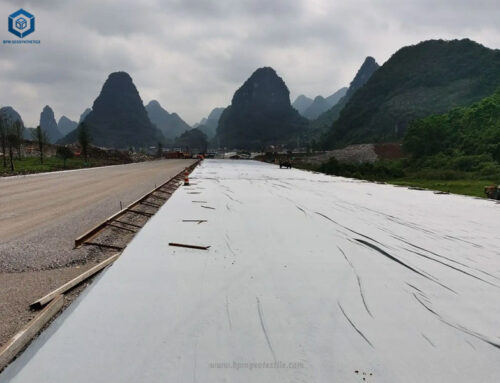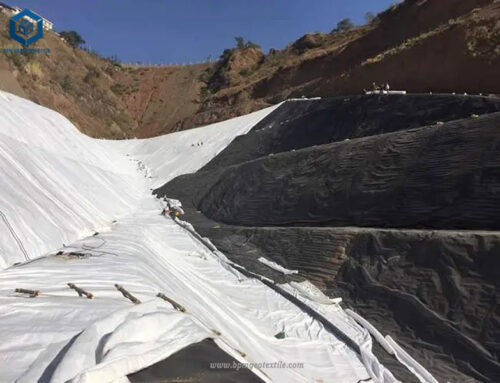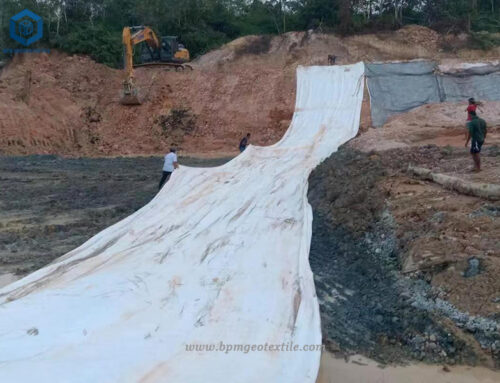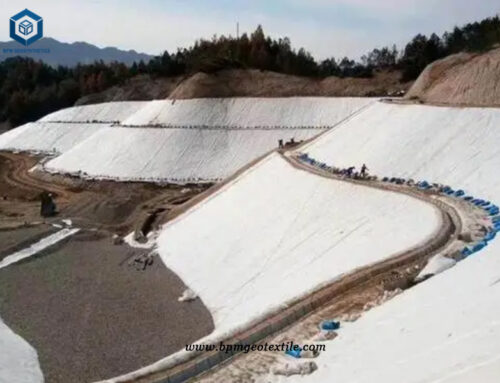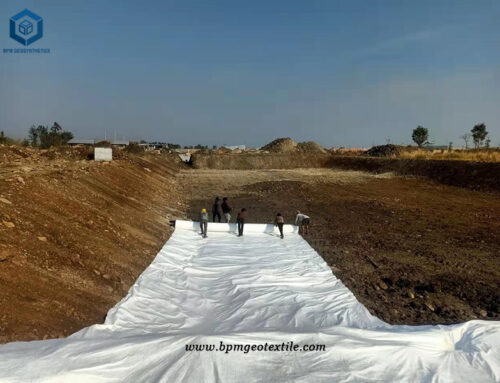High quality non woven geotextile, especially referring to short fiber non woven needle punched geotextile, is the most cost effective and extensively used geotextile fabric to ensure optimized performance and design life of soil or granular layers in a range of civil, coastal and environmental engineering projects. Needle punched geotextile fabric is felt-like and very flexible, having a fibrous network with distinctive pores, which makes them suitable for applications in filtration, drainage, separation and protection applications. Staple fibre needle punched geotextile is often manufactured from short polypropylene or polyester fibers. Polypropylene has good chemical stability and cost/weight ratio, but polyester offers good chemical resistance, high creep strength and tensile strength.
Case Study
- Location : Peru
- Product(s) : Nonwoven Geotextile
- Application : Mining Project
Issue
In mining projects, the tailings contain toxic substances or radioactive substances or heavy metal ions, which will seriously pollute the groundwater source, and seepage prevention treatment must be done.
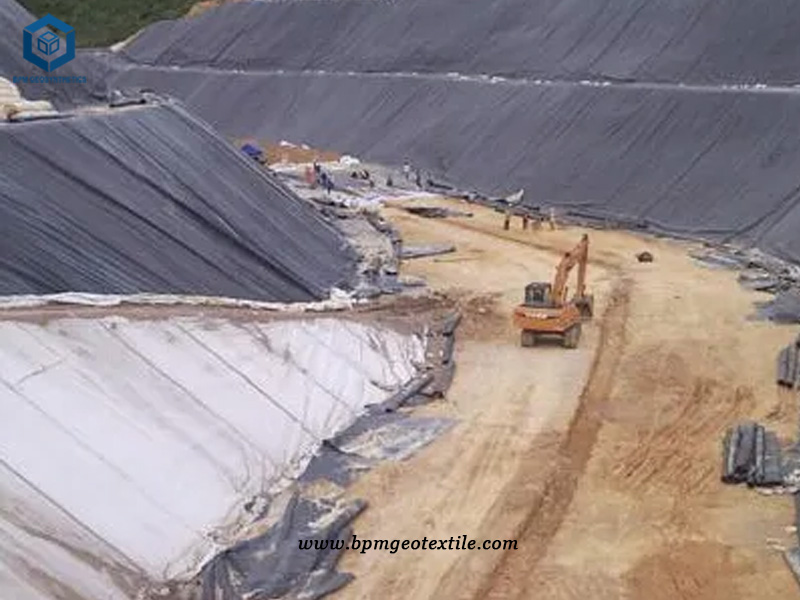

Solution
Staple fiber needle-punched geotextile, made from 100% virgin polypropylene fibers, is robust, durable, permeable, and resistant to deformation. BPM’s nonwoven geotextile fabric enhances ground support and soil stabilization with high tensile strength, elongation rate, UV stability, filtration, and abrasion resistance. It’s used for filtration, separation, protection, and drainage in civil engineering projects.
For a Chilean mining project needing 230,000 sqm of PP short fiber nonwoven geotextile for protection and reinforcement, BPM supplied the material due to its high tear and tensile strength, plus acid and alkali resistance, making it ideal for mining applications.
Specifications of high quality non woven geotextile for mining project
- Total PP Short fiber Nonwoven Geotextile quantity – 230,000m2
- PP Short fiber Nonwoven Geotextile specification – 300 g/m2
- Each roll size is 5.95m*50m
- Seven 40HQ containers
Functions of High Quality Non Woven Geotextile for Mining Project in Peru
1. Isolation.
Use polyester staple fiber needling method to separate building materials (such as soil particles, soil, soil and concrete, etc.) to disperse the corresponding physical personality (such as size, range, saturation and density, etc.). Ensure that there is no loss or mixing between two or more materials, ensure the original shape and performance of raw materials, and make the structure more superfrequency.
2. Filtration (inverted filtration).
Polyester staple fiber needled geotextile has good permeability and permeability, so that the liquid flows through, and can effectively guide soil particles, sand dust, small stones, etc., so as to ensure the stability of normal projects.
3. Drainage.
Polyester staple fiber needled geotextile has excellent water conductivity, which can create a water conduit inside the soil particles, and can discharge the remaining water and oxygen in it.
4. Reinforcement.
The use of geotextiles expands the toughness and impact resistance of soil, improves the stability of building structures, and improves the quality of soil.
5: Protection.
When water rushes into the soil, it can effectively spread, interact or decompose the concentrated stress, resist the impact damage of the soil and protect the land.
6: Anti penetration.
Composite impermeable material, made from geomembrane fusion, prevents stabbing. Excellent tensile strength ensures durability. Good permeability allows proper drainage. High temperature resistance for stability. Anti-freezing properties withstand cold climates. Anti-aging feature extends lifespan. Corrosion resistance enhances longevity. Wormproof design protects against pests. Polyester staple fiber needled geotextile is widely used. Reinforces railway subgrades effectively. Maintains highway pavement integrity. Used in gymnasium construction. Protects dams from environmental damage.


Geotextile construction precautions
Do not drag or drag the geotextile during transportation to avoid stabbing by sharp objects.
- Before construction, clean the substrate thoroughly. If possible, wash with water to remove impurities. Repair cracks in the base with asphalt. Ensure proper pavement and final use effectiveness.
- When paving, straighten the material as much as possible. Ensure the material is laid flat for optimal base contact. If oily residue on bottom, use a roller brush to apply evenly. Sprinkle melon seeds or coarse sand for better adherence.
- Ensure woven fabric is dry before paving. Wet fabric reduces effectiveness after rain. Wait until completely dry if it gets wet. No smoking allowed during the laying process. Avoid walking on the surface immediately after completion. Do not move tools or place heavy objects on it.
- There should be some overlap at the lap joint, and the effect will be better after layer by layer pavement. The joint can be welded, so the stability is better. In addition, pay attention to the slope and the position of the corner, where the splicing length can be shortened to avoid wrinkles.
Construction method
- It should extend from the bottom to the high position, and should not be pulled too tightly. There should be a half of the remaining width for local sinking and stretching. Considering the actual situation of the project, the slope is paved from top to bottom;
- The longitudinal joints of two adjacent frames shall not be on the same horizontal line, and shall be staggered by more than 1m;
- The longitudinal joint should be more than 1 or 50m away from the dam toe and bend, and should be set on the plane;
- Slope first and then the bottom of the site; What are the characteristics and functions of geotextiles used in construction;
- When laying the slope, the film spreading direction should be basically parallel to the slope line.
About BPM
BPM manufactures and wholesales many types of effective and states of the art geotextile, geomembrane, and other geosynthetics to over 36 countries. BPM geosynthetic products are widely used across a variety of industries including waste containment, water containment, aquaculture, industrial project, energy project and mining projects, etc. Our main customers are from Australia, France, Sweden, UK, Hungary, New Zealand, Poland, Mexico, Ecuador, Brazil, Pakistan, Bangladesh, Thailand, Vietnam, Malaysia, Indonesia, Singapore, Philippines, Sri Lanka, India, UAE, Saudi Arabia, Qatar, Kenya, etc.
BPM is not only manufacturing best quality geosynthetic products but also providing professional design and installation service. OEM, ODM, custom development and fabrication are also available. If you have any questions or inquiries, please fill and submit the following form, we will reply as soon as possible.

